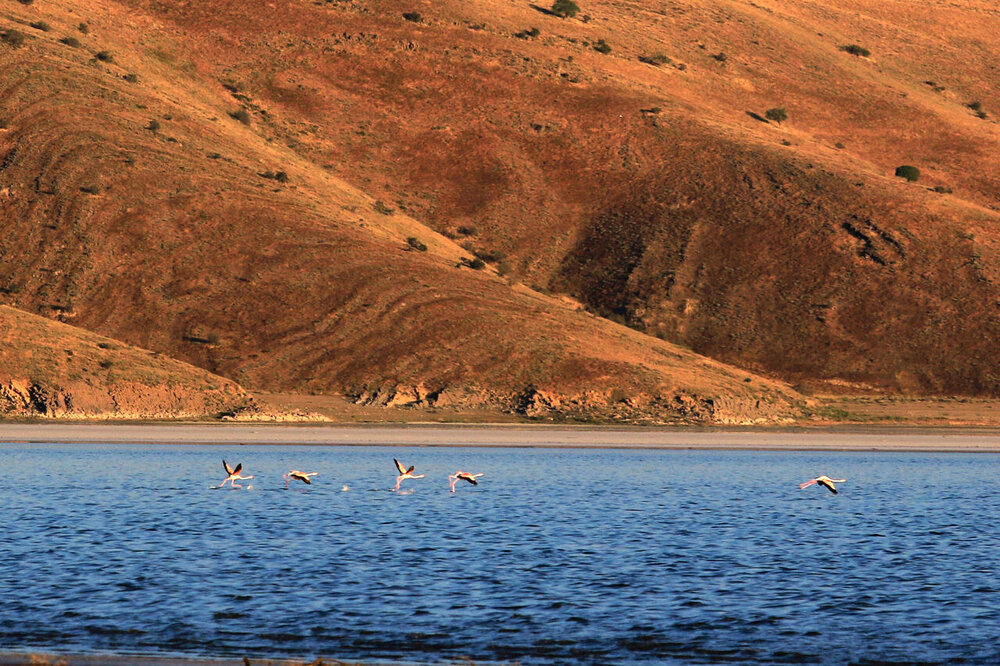Safeguarding our vanishing treasure; National Park of Lake Urmia

TEHRAN – The National Park of Lake Urmia, home to several precious species and amongst 59 biosphere reserve areas, is severely threatened by many years of drought so that it needs to be restored urgently to avoid the extinction of highly adapted species.
Shared between West Azarbaijan and East Azarbaijan provinces in northwestern Iran, Lake Urmia, was once the largest salt-water lake in the Middle East. It was home to many migratory and indigenous animals including flamingos, pelicans, egrets and ducks and attracted hundreds of tourists every year who had bathed in the water to take advantage of the therapeutic properties of the lake.
However, decades of long-standing drought spells and elevated hot summer temperatures that speed up evaporation as well as increased water demands in agriculture sector shrank the lake drastically. In 1999 the volume of water which was at 30 billion cubic meters drastically decreased to half a billion cubic meters in 2013. Moreover, the lake surface area of 5,000 square kilometers in 1997 shrunk to one tenth of that to 500 square kilometers in 2013.
The lake hosted diverse bacterial communities, hyperhalophilous phytoplanktons, and notably the macrozooplankton crustacean, the brine shrimp Artemia urmiana.
Thus, with regard to its ecological significance, unique biodiversity and the presence of indigenous communities, Lake Urmia has been recognized as a protected area since 1967 and was designated as a National Park in 1976 as one of 59 biosphere reserves by UNESCO.
The National Park of Lake Urmia consists of approximately 102 islands; Shahi island was historically the lake's largest. However, it became a peninsula connected to the eastern shore when the lake level dropped. Some of the islands have a rich ecosystem due to being out of reach.
The sharp rise in precipitations rates in the area has raised hopes for total restoration of the once glorious Lake Urmia.
Based on the latest data published by the National Drought Warning and Monitoring Center, since the current crop year (September 23, 2018), precipitation in the country considerably increased to 314.5 millimeters from 159.3 millimeters in the previous water year, demonstrating a 95.9 percent rise.
However, the rainfall fluctuations are not permanent and after hot seasons with scorching temperatures, the lake will face high evaporation again and go dry soon.
Therefore, the lake’s islands will face the threat of losing precious species, as well.
Two islands of Ashk and Kaboodan burdened the direct consequences of drying Lake Urmia, loosing many of their wildlife species, Hamid Zohrabi, deputy chief of the Department of Environment (DOE), told Tasnim on Wednesday.
The islands once were the main habitats for two herbivorous species of Persian fallow deer and Armenian mouflon, which have been endangered due to the lake's improper conditions in recent years, he lamented.
“There are four projects aimed at revitalizing the islands’ ecosystems and preserving the wildlife, namely, managing the population of Persian fallow deer in Ashk island and managing the population of Armenian mouflon in the islands of Lake Urmia,” he explained.
He went on to say that expanding vegetation cover in the islands and the National Park of Lake Urmia and ecological conservation of the southeast side of the Lake are among the plans.
The plans will be implemented in a collaborative initiative between the DOE’s natural environment and biodiversity directorate, the Lake Urmia conservation program and the West Azarbaijan department of environment, he noted.
Behzad Shir Panjeh, head of National Park of Lake Urmia, has said that this year, with appropriate rainfall, the islands’ reservoirs have become saturated, along with favorable vegetation providing conditions for the endemic species to live and breed.
Kaboodan island is located on mountainous areas and is considered a unique habitat for the regeneration of Persian fallow deer and Armenian mouflon, he highlighted.
Referring to the island stretching to over 3,000 hectares, he noted that it is controlled and monitored by the DOE.
Armenian mouflon lives in other islands of the Lake Urmia, including Espir, Ashk and seasonally in Arezoo island, but their main habitat is Kaboodan island due to good vegetation and water resources, he explained.
Currently, over 1,200 Armenian mouflon are inhibiting in the national park, and the annual census will begin again in the Iranian calendar month of Aban (November 23-October 21), he concluded.
More detailed and scientific studies are needed to document the lake’s composition, which is facing the threat of disappearing. Saline lakes mostly have a fragile environment which requires careful protection to prevent the highly adapted species from extinction.
Although, lake level fluctuations have always been part of the lake’s history and have affected the diversity of microbial plants and marine species in the lake, the recent environmental issues of Lake Urmia cannot be the reason to exploit more of such a fragile ecosystem.
Therefore, wiser restoration programs are needed to minimize the human interventions in the lake and associated ecosystems as well as reducing the threats.
FB/MG
